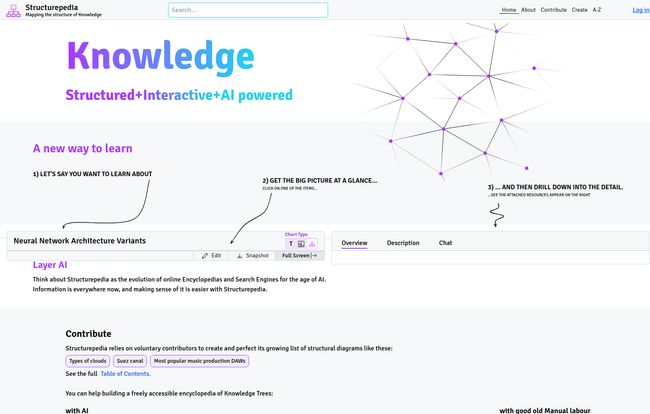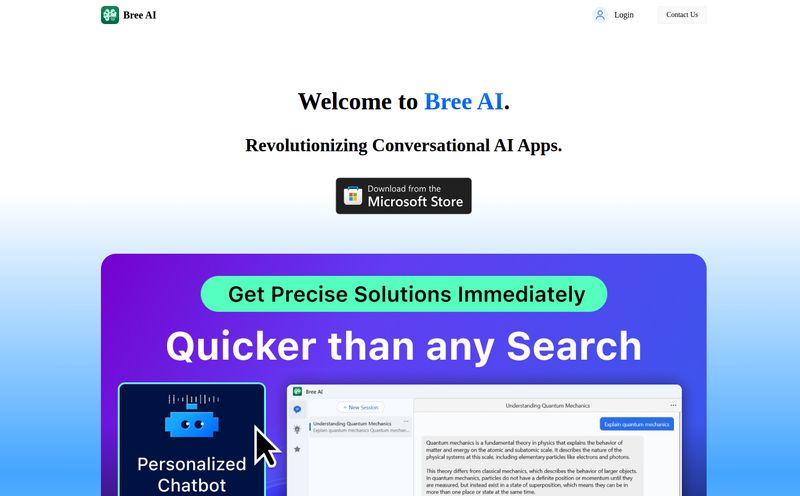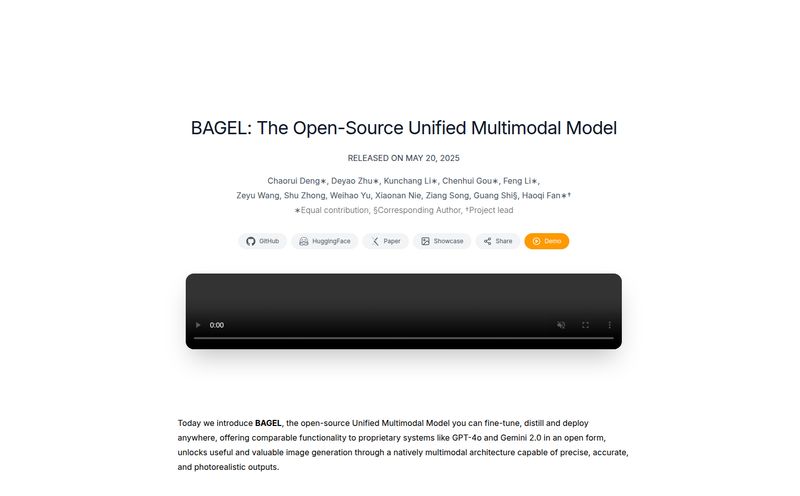We’ve all been there. It’s 11 PM, you’ve clicked on a single Wikipedia link out of curiosity, and suddenly it’s 2 AM. You've tumbled through a rabbit hole of hyperlinks, tabs are multiplying like rabbits, and you now know the entire history of the spork but have completely forgotten what you were trying to learn in the first place. Information overload is real, and the traditional, linear way we consume knowledge online often feels like trying to drink from a firehose.
For years, I've been looking for something... different. Something that respects how our brains actually work—through connections, hierarchies, and big-picture views. So when I stumbled upon Structurepedia, my SEO-tuned senses started tingling. The tagline? “Mapping the structure of knowledge.” Okay, you have my attention.
What Exactly is Structurepedia?
Think of Structurepedia as the love child of a search engine, Wikipedia, and a mind-mapping tool. Instead of dumping a wall of text on you, it generates a visual, interactive knowledge tree for your query. It's a platform built on a simple but powerful idea: learning something new shouldn't be about memorizing a linear list of facts. It’s about understanding the structure of a topic—how the main ideas branch into smaller concepts, and how they all connect.
It’s an encyclopedia for the age of AI, aiming to present information in a way that mimics how knowledge is actually represented in our heads. A big claim, I know. So I had to see if it lived up to the hype.
My First Impressions: Taking Structurepedia for a Spin
The homepage keeps it simple. It lays out a three-step process: 1) State what you want to learn, 2) Get the big picture, 3) Drill down into the details. Simple enough.
I decided to look at one of their pre-made examples, “Neural Network Architecture Variants.” As someone who has tried to get my head around AI concepts from dense articles, this was a perfect test case.

Visit Structurepedia
Instantly, a diagram popped up. Not a list, not a paragraph, but a clean, branching tree. At the center was the main topic, and branching off were the major types of architectures. Each of these branches, or 'nodes,' could be clicked. Clicking on one didn’t just take you to another page; it expanded the tree further, revealing more detail. And on the right-hand side, you could pull up in-depth resources for any selected node. Voilà! The big picture and the fine details, all in one cohesive view. It’s like having a subway map for a complex subject. You can see all the main lines and stations, and then zoom in on the specific street you need to be on.
The Core Philosophy: Why Visual Structure Matters
This is the part that really resonated with me. Structurepedia’s philosophy page points out that while books and blogs are great, they often obscure the underlying structure of a topic. I couldn’t agree more. As an SEO professional, a huge part of my job is creating 'topic clusters'—a main pillar page with supporting articles that branch off. It helps Google understand expertise and context. Structurepedia is basically doing that, but they’re visualizing it for the human user. It’s topic clustering on steroids.
Our brains don't think in neat, orderly paragraphs. We think in webs of association. This tool feels like it was designed with that in mind. It's a fundamentally different approach from the endless scroll we’ve become accustomed to. For anyone who's a visual learner, it just… clicks.
The Good, The Bad, and The AI
No tool is perfect, of course. After my initial excitement, I started digging in with a more critical eye. Here’s my honest breakdown.
The Bright Side: What I Really Liked
The visual and interactive experience is, without a doubt, the star of the show. It transforms passive reading into active exploration. The ability to see the whole structure and then dive into a specific node without losing context is fantastic. The nodes themselves are also packed with more in-depth resources, making it a great starting point for serious research.
I also have to give a nod to the AI-powered suggestions. When you go to create a tree or search, a little helper called 'StructBot' can give you suggestions to formulate your query. It’s a nice touch that can help you frame your topic in a way that will yield a better structural diagram.
A Few Caveats to Keep in Mind
Here’s the catch: Structurepedia relies on voluntary contributors. This is both a strength and a weakness. It means the platform can grow organically with passionate experts building out diagrams. But it also means that coverage can be uneven. You might find an incredibly detailed map for 'Types of Clouds' but a very sparse one for '18th Century French Literature'.
The effectiveness of the whole thing also hinges on the quality of the diagrams themselves. A well-structured tree is a revelation; a poorly structured one can be just as confusing as a badly written article. Its a bit of a gamble, but one I think is worth taking for the potential upside.
How Does Structurepedia Make Money? The Pricing Question
This is where things get interesting. As a CPC guy, I'm always curious about the business model. I went looking for a pricing page and... hit a 404. “The page for ‘pricing’ does not exist.”
From what I can gather, Structurepedia is currently free to use. The content is published under a Creative Commons Attribution-ShareAlike License, which further points to a community-first, open-access ethos. It seems to be a passion project, likely funded by its creators or maybe grants, with a focus on building a valuable resource first. I respect that. It feels less like a product and more like a public utility for knowledge.
Who is Structurepedia For?
So, who should drop what they're doing and check this out? I’d say it’s a dream tool for a few specific groups:
- Students: Trying to revise for an exam or get your head around a tough new subject? This could be a game-changer.
- Lifelong Learners: If you're just curious about the world and love learning for its own sake, this is a much more engaging way to do it than falling down the usual rabbit holes.
- Researchers & Content Creators: I can already see myself using this to map out complex article series or understand the landscape of a new niche. It’s a great way to organize your thoughts and see the gaps in your knowledge.
Basically, if you've ever felt overwhelmed by a wall of text and wished someone would just draw you a map, this platform is for you.
Final Thoughts: Is Structurepedia Worth Your Time?
Absolutely. Yes. Is it going to replace Google tomorrow? No. Is it a perfect, comprehensive repository of all human knowledge? Not yet. But that's not the point. Structurepedia is an exciting, innovative experiment in how we can better organize and interact with information. It's a tool with a strong point of view, and I for one am excited to see how its user-created encyclopedia of diagrams continues to grow.
It’s a refreshing change of pace in a digital world dominated by infinite scrolls and algorithmic content feeds. It encourages a more deliberate, structured, and ultimately, a more intuitive way of learning. Give it a try. The worst that can happen is you actually understand that complex topic you’ve been putting off.
Frequently Asked Questions about Structurepedia
- What is Structurepedia?
- Structurepedia is a unique online tool that functions as a mix between a search engine and an encyclopedia. It generates interactive, visual diagrams or “knowledge trees” to help users understand the structure of complex topics, rather than just reading linear text.
- Is Structurepedia free to use?
- Yes, based on our research and the absence of a pricing page, Structurepedia appears to be completely free to use. The content is also shared under a Creative Commons license, emphasizing its open-access nature.
- How does the AI work in Structurepedia?
- The AI, referred to as 'StructBot', assists users by providing suggestions for how to formulate their search queries. This helps in creating more effective and well-organized structural diagrams for the topic you want to learn about.
- Can I contribute to Structurepedia?
- Yes! The platform is built on voluntary contributions. Users can create and edit knowledge trees to help expand the encyclopedia. They have a contribution guide on their website to help new users get started.
- What are the main alternatives to Structurepedia?
- While its hybrid approach is fairly unique, you could compare its visual organization aspect to mind-mapping tools like Miro or Xmind. For information depth, its alternative is traditional encyclopedias like Wikipedia, though the presentation is fundamentally different.
- Is the information on Structurepedia reliable?
- The reliability of the information can vary since it's a community-driven platform, similar to Wikipedia. The quality of a knowledge tree depends on the contributor. However, nodes often link to external, in-depth resources, allowing you to verify information from primary sources.
Reference and Sources
- Structurepedia Homepage: https://structurepedia.com/
- Creative Commons License: https://creativecommons.org/licenses/by-sa/4.0/
- Structurepedia on X (formerly Twitter): https://twitter.com/structurepedia



